
By Leith van Onselen
In April last year, outgoing Reserve Bank of New Zealand (RBNZ) governor, Alan Bollard, muted introducing ‘maco-prudential’ tools to prevent the formation of future asset price bubbles:
“[New Zealand needs] to keep preparing for how we might deal with credit and asset price booms when they recur in the future,” Bollard says. “Our work so far on macro-prudential instruments suggests that we should keep our expectations modest, but we have identified several tools that we would contemplate using in the right circumstances.”
He notes past “periods of unsustainably strong credit growth and asset price cycles” which have had damaging effects on the economy and the financial system.
“We will certainly face similar developments in the future, so we want to develop our macro-prudential toolkit now to enhance our ability to deal with them when the time comes,’ says Bollard.
Rapid credit and asset price growth had amplified general economic cycles and made monetary policy’s task of controlling inflation more difficult.
“We have seen the difficulties that can arise when interest rates alone are used,” Bollard says.
“The collateral damage to the net export sector from the high New Zealand dollar exchange rate during the previous economic upswing prompted a search for potential tools to assist monetary policy. Now, in light of the broader and significant social and macroeconomic costs arising from financial system distress in the aftermath of the global financial crisis, there is greater will to consider additional tools.”
At the time, Bollard won bipartisan support for the proposed macro-prudential tools, with both the incumbent National Party Government and the Labour Opposition signalling their support for the proposal.
Since that time, the New Zealand housing market has hit a bit of a purple patch, with both home loan approvals and house prices trending up (see below charts).
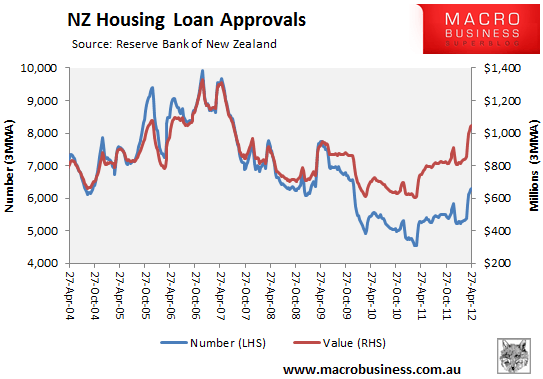
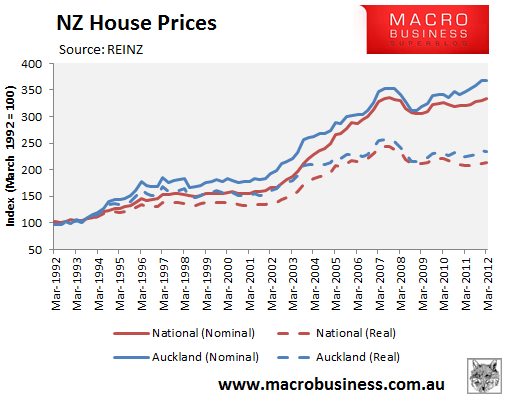
In nominal terms, New Zealand house prices are back to their peak level reached in November 2007 (higher in Auckland), but remain some -13% lower in real (inflation-adjusted) terms (-9% lower in Auckland).
The recent increase in New Zealand home prices has raised concerns that the country may be on the verge of another housing boom, fuelled by low mortgage interest rates which, when combined with falling levels of debt, has reduced the debt servicing costs of New Zealand households (see below charts).
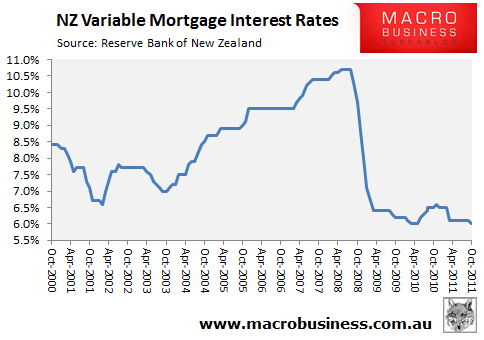
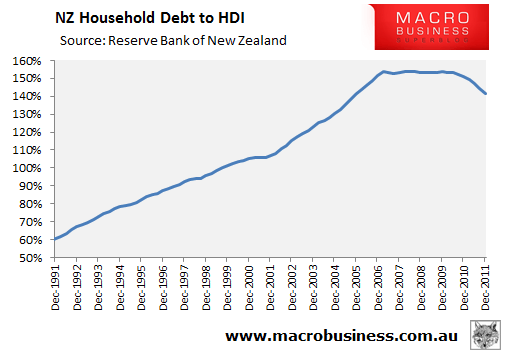
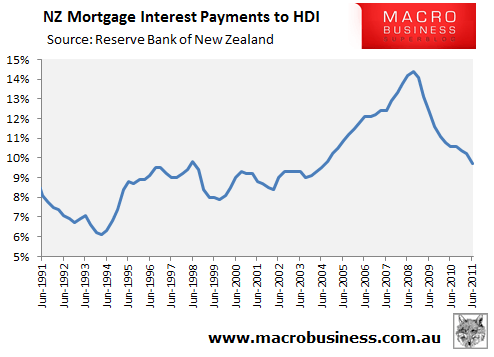
Whilst there appears to be broad support on the need to develop new macro-prudential measures in order to prevent housing bubbles and spur New Zealand’s export and productive sectors, the RBNZ’s loose monetary policy (official interest rates are at 2.5%) combined with the recent increasing of loan-to-value ratios by the banks (see here and here), appears to be having the opposite effect of providing renewed fuel to the housing market.
Accordingly, the RBNZ has once again muted implementing macro-prudential measures to dampen future credit bubbles:
[Deputy RBNZ Governor, Grant Spencer] acknowledged the Reserve Bank’s existing prudential regulatory framework failed to take account of the growing systemic risk arising from a boom in credit and asset prices between 2002 and 2007, which “aggravated” the severity of the GFC.
“Many banks had adopted capital models that tended to reduce the capital backing of loans when markets were strong and increase capital backing when markets were weak. In this sense, the existing prudential framework failed to take account of the growing systemic risk arising from the sustained boom in credit and asset prices that occurred between 2002 and 2007,” Spencer said.
“The lesson was clear: prudential policy should take more account of macro-financial risks as well as the micro-financial risks specific to individual banks”…
Reserve Bank staff have been doing “a lot of thinking” about potential macro-prudential policy instruments and how they might be used.
“In broad terms macro-prudential policies are aimed at reducing financial system risk by introducing additional safeguards, such as capital and liquidity buffers or collateral requirements that vary with the macro-credit cycle,” Spencer said. “Such policies will also tend to have the effect of either: 1) dampening the credit cycle; or 2) dampening international capital flows and hence exchange rate pressures. For those reasons, macro-prudential policies might be expected to play a useful secondary role in helping to stabilise the macro-economy.”
Four instruments the Reserve Bank currently considers “viable candidates” include: the Counter Cyclical capital Buffer, which is described as an additional capital requirement that local bank supervisors may apply when credit is booming, and remove when the cycle is turning down. It’s part of the Reserve Bank’s Basel III plans (see more on this option here). Spencer also highlighted the Core Funding Ratio, adjustments to sectoral risk weights used to calculate Risk Weighted Assets under the Basel capital adequacy regime and limits on LVRs.
The inclusion of the last option is perhaps the most significant. The recent resurgence of the Auckland housing market comes with three of the country’s big four banks growing their residential mortgage lending with LVRs above 90%. See more here.
“The Reserve Bank already has powers under the Reserve Bank Act to modify prudential instruments with the objective of financial system stability and efficiency. However, this is a new approach to prudential policy and as such we are developing, along with Treasury, an explicit macro-prudential governance framework to be agreed with the Minister of Finance (Bill English) as a basis for policy decisions going forward,” said Spencer.
The New Zealand authorities, and the RBNZ in particular, should be commended for examining ways to reduce their country’s macroeconomic vulnerabilities, even if reform is taking place at a snail’s pace. This is in stark contrast to Australia, whose authorities are yet to publicly acknowledge that such vulnerabilities even exist.
In this regard, New Zealand is way ahead of the curve in thinking through how to handle the financial stability aspects of housing/credit cycles.

